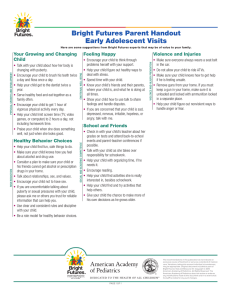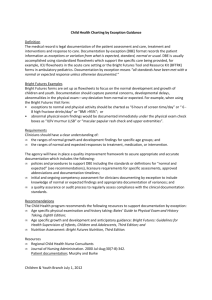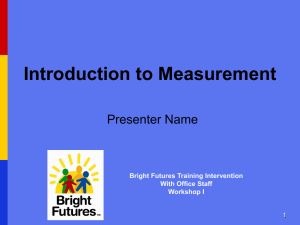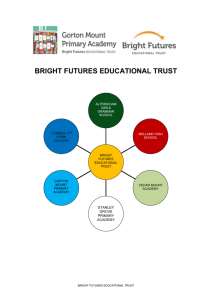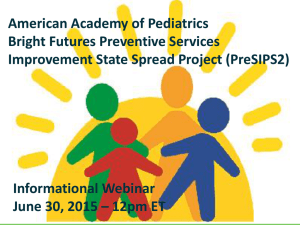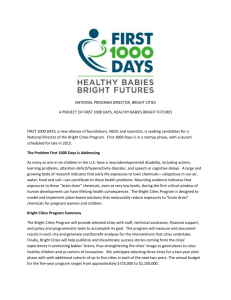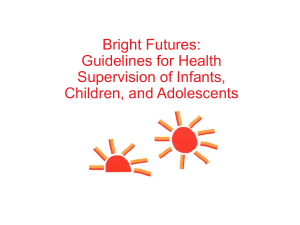Accelerating and Sustaining Improvement:
advertisement
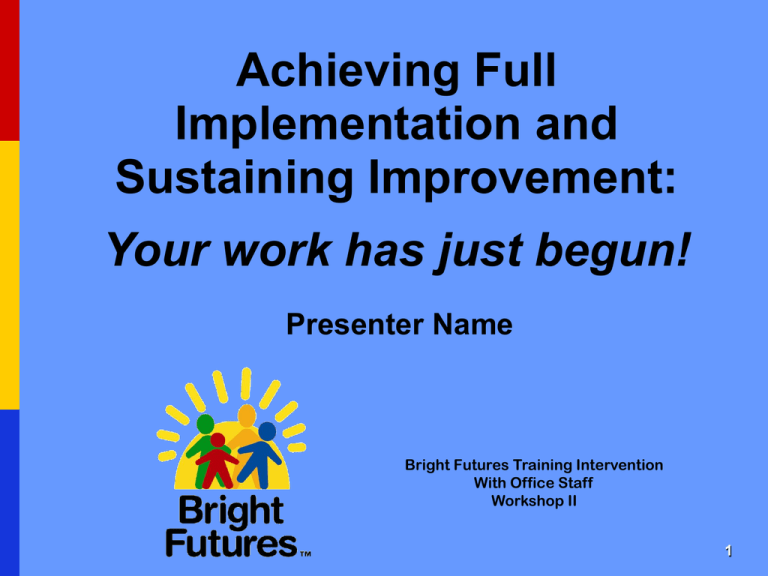
Achieving Full Implementation and Sustaining Improvement: Your work has just begun! Presenter Name Bright Futures Training Intervention With Office Staff Workshop II 1 Sustainability “There will come a time when you think you are finished. That will be the beginning.” -Louis L’Amour 2 Overview Describe strategies for moving from testing to full implementation of Bright Futures components. Describe key strategies for sustaining improvements. 3 Implementing Improvements: The “Ripple Effect” 4 The Inner Circle of Improvement: Your Bright Futures Practice Team Group most invested in improvement Small size of group streamlines process of adoption/adaptation of new ideas Conducts initial Plan-Do-Study-Act cycles 5 Tests of Change Changes that result in improvement Ideas 6 Moving Beyond the Inner Circle: Beginning Implementation Identify larger group (10-15 staff members). Communicate your previously tested improvement. Let larger group “own” idea and suggest further changes. Test modified improvement in larger group using Plan-Do-Study-Act cycle(s). 7 Extending the “Ripple Effect” of Improvement: Full Implementation Expand group to include all staff affected by improvement. Invite further input. Invite acceptance. Implement improvement practice-wide. Provide immediate and periodic feedback. 8 Managing Change: Avoiding Surprises 9 Overcoming Resistance to Full Implementation Provide reassurance that there is always room for clinical judgment. Make your improvement the “default” option in your system. 10 Sustaining Improvement 11 Why Focus on Sustaining Improvement? 12 Sustainability: Key Strategies Assign ownership of system. Hardwire sustainability into the system. Continue selected measurement. Senior leadership. 13 Ownership Assign Coordinator/Team to “Own” Bright Futures Training Intervention With Office Staff Conduct regular meetings, senior leader updates. Assess critical success factors. Review data. Design ongoing improvements (Plan-Do-Study-Act cycles). Communicate. Frequent and ubiquitous. Celebrate successes and have fun! 14 Critical Success Factors Must Dos Must Haves Must Results Must Whens Must Whos 15 “Hardwire” Sustainability Involve all staff. Job descriptions. Staff evaluations. Plan for turnover/absences. Staff orientation includes training in newly implemented Bright Futures components. Educate patients—create accountability. 16 Sustaining—Training You must have a method to continually train the entire staff. Introduce concepts. Conduct orientation of new staff members. Continue to post results. Continue to celebrate. 17 Ongoing Measurement Simplify measures—shift to auditing mode when possible. Decrease number. Decrease frequency. Automate or use simple tools. Use it! Meetings, planning, day-to-day, marketing, accreditation. Make culture “data driven.” 18 Importance of Senior Leaders Key to resources. Establish level of priority. Create accountability. Advocacy role. Shared vision. 19 What Happened? Why Didn’t We Sustain Our Improvement? 20 The Devil Is in the Details We assumed that everything would keep running as planned. We quit monitoring progress. We are now playing catch-up. 21 Lessons Learned DON’T assume what you have done will automatically continue. DON’T stop training key staff. DO continue to monitor and report on results. DO continue to modify and improve. » And ALWAYS remember… 22 It ain’t over til it’s over…. Yogi Berra 23 “And it’s never over…” Anonymous participant in Quality Improvement Collaborative 24 References Langley J, Nolan K, Nolan T, Norman C, Provost L. The Improvement Guide. San Francisco, CA: Jossey-Bass; 1996 Trustees of Dartmouth College. Clinical Microsystems. http://www.clinicalmicrosystem.org. Accessed January 12, 2009 25 Tips and Strategies for Ongoing Bright Futures Measurement 26 Beyond the Workshop: Principles for Ongoing Bright Futures Data Collection Reduce frequency of data collection (quarterly?). Enter monitoring/surveillance mode. Transition to managing data collection and monitoring results internally at your practice. 27 Beyond the Workshop: Principles for Ongoing Bright Futures Data Collection Can continue to use same data collection instruments (chart review forms, parent surveys) 28 Monitoring Improvement: Continuing Data Collection Worksheet 29 Sample Ongoing Data Collection: Preventive Services Prompting System Proposed monitoring tool: Bright Futures Chart Review Tool Suggested frequency: Quarterly Suggested quantity: Ten consecutive patients 30 Sample Ongoing Data Collection: Preventive Services Prompting System Identify questions Is a preventive services prompting sheet on the chart? Is there at least one entry on the preventive services prompting sheet within the past 12 months? Count number of chart review with “yes” responses to both questions. Convert number to proportion of 10 charts reviewed (eg, If 5 have a preventive services prompting system, then proportion is 0.5). Enter proportion where indicated on worksheet. 31 Using an Excel Spreadsheet to Enter Your Own Data Date PSPS Nov 05 0.5 Dec 05 Jan 06 Feb 06 Mar 06 Apr 06 May 06 Jun 06 Jul 06 Aug 06 32 Generating Your Own Run Charts: It is easy using the Ongoing Data Collection Worksheet! PSPS 100% 80% 60% 40% 20% 0% Nov 09 Dec 09 Jan 10 Feb 10 Mar 10 Apr 10 May 10 Jun 10 Jul 10 Aug 10 33 Ongoing Data Collection Recall and Reminder and Community Linkages: Bright Futures Office Systems Inventory annually 34 Ongoing Measurement: Closing Messages Keep it simple! Keep it going! 35
